child lock PORSCHE BOXSTER 2009 2.G Owners Manual
[x] Cancel search | Manufacturer: PORSCHE, Model Year: 2009, Model line: BOXSTER, Model: PORSCHE BOXSTER 2009 2.GPages: 294, PDF Size: 6.89 MB
Page 8 of 294
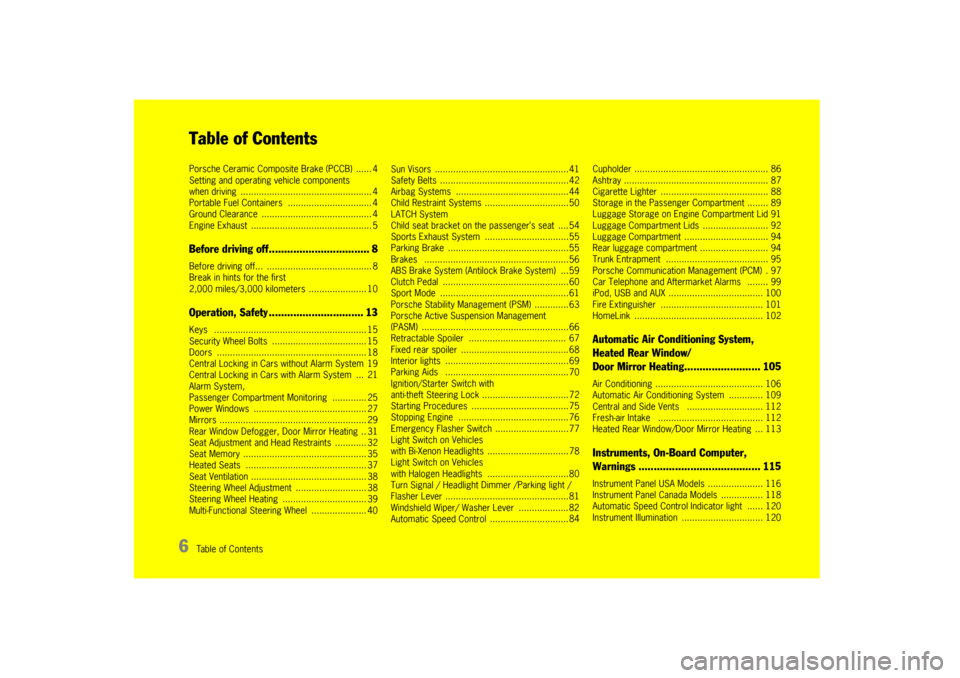
6
Table of ContentsTable of ContentsPorsche Ceramic Composite Brake (PCCB) ...... 4
Setting and operating vehicle components
when driving .................................................. 4
Portable Fuel Contain ers ................................ 4
Ground Clearance ...... .................................... 4
Engine Exhaust .......... .................................... 5Before driving off................................. 8Before driving off... ........................................ 8
Break in hints for the first
2,000 miles/3,000 kilo meters ...................... 10Operation, Safety ............................... 13Keys ........................ .................................. 15
Security Wheel Bolts .................................... 15
Doors ................................................ ......... 18
Central Locking in Cars without Alarm System 19
Central Locking in Cars with Alarm System ... 21
Alarm System,
Passenger Compartment Monitoring ............. 25
Power Windows ............. .............................. 27
Mirrors ...................... .................................. 29
Rear Window Defogger, Door Mirror Heating .. 31
Seat Adjustment and Head Restraints ............ 32
Seat Memory ............. .................................. 35
Heated Seats ............ .................................. 37
Seat Ventilation ...... ...................................... 38
Steering Wheel Adjust ment ........................... 38
Steering Wheel Heatin g ................................ 39
Multi-Functional Steering Wheel ..................... 40 Sun Visors ...............
....................................41
Safety Belts ............. ....................................42
Airbag Systems ....... ....................................44
Child Restraint System s ................................50
LATCH System
Child seat bracket on the passenger’s seat ....54
Sports Exhaust System ................................55
Parking Brake .......... ....................................55
Brakes ................... ....................................56
ABS Brake System (Antilock Brake System) ...59
Clutch Pedal ................ ................................60
Sport Mode ................. ................................61
Porsche Stability Manage ment (PSM) .............63
Porsche Active Suspension Management
(PASM) ........................ ................................66
Retractable Spoiler .. ................................... 67
Fixed rear spoiler . ........................................68
Interior lights ................................ ...............69
Parking Aids ........... ....................................70
Ignition/Starter Switch with
anti-theft Steering Lo ck .................................72
Starting Procedures .....................................75
Stopping Engine .. ........................................76
Emergency Flasher Swit ch ............................77
Light Switch on Vehicles
with Bi-Xenon Headlig hts ...............................78
Light Switch on Vehicles
with Halogen Headlights ...............................80
Turn Signal / Headlight Dimmer /Parking light /
Flasher Lever ........... ....................................81
Windshield Wiper/ Washer Lever ...................82
Automatic Speed Contro l ..............................
84Cupholder ...................
................................ 86
Ashtray ....................... ................................ 87
Cigarette Lighter .... ..................................... 88
Storage in the Passenger Compartment ........ 89
Luggage Storage on Engine Compartment Lid 91
Luggage Compartment Li ds ......................... 92
Luggage Compartment ................................ 94
Rear luggage compartm ent .......................... 94
Trunk Entrapment .. ..................................... 95
Porsche Communication Management (PCM) . 97
Car Telephone and Aftermarket Alarms ........ 99
iPod, USB and AUX . ................................... 100
Fire Extinguisher .... ................................... 101
HomeLink ................... .............................. 102
Automatic Air Conditioning System,
Heated Rear Window/
Door Mirror Heating. ........................ 105Air Conditioning ...... ................................... 106
Automatic Air Conditioning System ............. 109
Central and Side Vents ............................. 112
Fresh-air Intake . ....................................... 112
Heated Rear Window/Door Mirror Heating ... 113Instruments, On-Board Computer,
Warnings ........................................ 115Instrument Panel USA Models ..................... 116
Instrument Panel Canada Models ................ 118
Automatic Speed Control Indicator light ...... 120
Instrument Illumination ............................... 120
Page 15 of 294
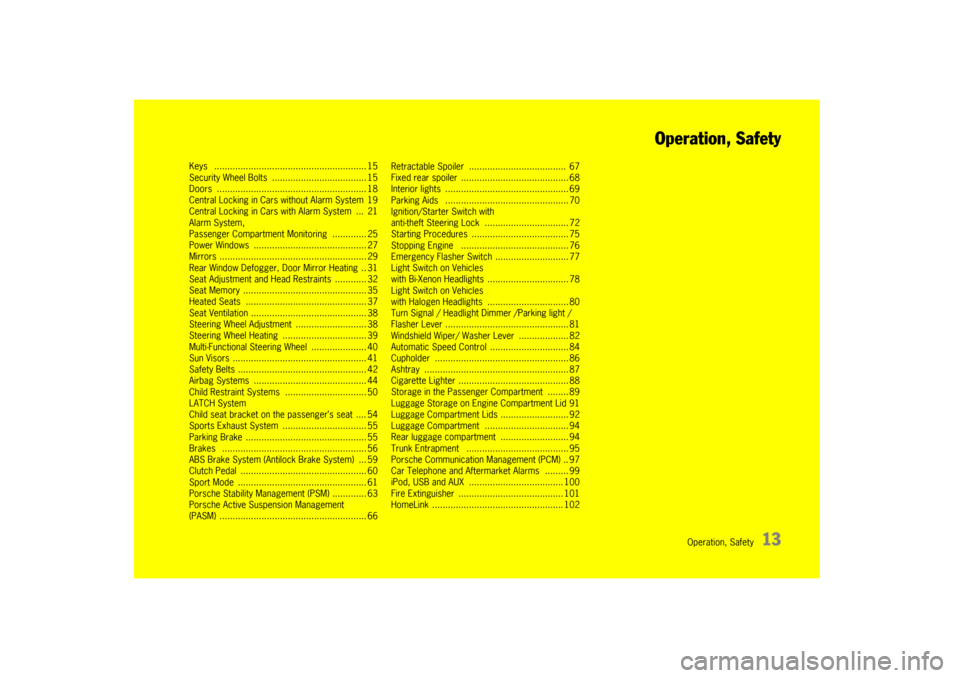
Operation, Safety
13
Operation, Safety
Keys ........................
.................................. 15
Security Wheel Bolts .................................... 15
Doors ................................................ ......... 18
Central Locking in Cars without Alarm System 19
Central Locking in Cars with Alarm System ... 21
Alarm System,
Passenger Compartment Monitoring ............. 25
Power Windows ............. .............................. 27
Mirrors ...................... .................................. 29
Rear Window Defogger, Door Mirror Heating .. 31
Seat Adjustment and Head Restraints ............ 32
Seat Memory ............. .................................. 35
Heated Seats ............ .................................. 37
Seat Ventilation ...... ...................................... 38
Steering Wheel Adjust ment ........................... 38
Steering Wheel Heatin g ................................ 39
Multi-Functional Steering Wheel ..................... 40
Sun Visors ................. .................................. 41
Safety Belts ............... .................................. 42
Airbag Systems ......... .................................. 44
Child Restraint System s ............................... 50
LATCH System
Child seat bracket on the passenger’s seat .... 54
Sports Exhaust System ................................ 55
Parking Brake ............ .................................. 55
Brakes ..................... .................................. 56
ABS Brake System (Antilock Brake System) ... 59
Clutch Pedal .............. .................................. 60
Sport Mode ............... .................................. 61
Porsche Stability Mana gement (PSM) ............. 63
Porsche Active Suspension Management
(PASM) ...................... .................................. 66 Retractable Spoiler ..
................................... 67
Fixed rear spoiler . ........................................ 68
Interior lights ................................ ............... 69
Parking Aids ........... .................................... 70
Ignition/Starter Switch with
anti-theft Steering Lo ck ................................ 72
Starting Procedures ..................................... 75
Stopping Engine . ........................................ 76
Emergency Flasher Swit ch ............................ 77
Light Switch on Vehicles
with Bi-Xenon Headlights ............................... 78
Light Switch on Vehicles
with Halogen Headlights ............................... 80
Turn Signal / Headlight Dimmer /Parking light /
Flasher Lever ........... .................................... 81
Windshield Wiper/ Wash er Lever ................... 82
Automatic Speed Control .............................. 84
Cupholder ................... ................................
86
Ashtray ....................... ................................ 87
Cigarette Lighter ...... .................................... 88
Storage in the Passenger Compartment ........ 89
Luggage Storage on Engine Compartment Lid 91
Luggage Compartment Li ds .......................... 92
Luggage Compartment ................................ 94
Rear luggage compartm ent .......................... 94
Trunk Entrapment ... .................................... 95
Porsche Communication Management (PCM) .. 97
Car Telephone and Aftermarket Alarms ......... 99
iPod, USB and AUX .. .................................. 100
Fire Extinguisher .. ...................................... 101
HomeLink .................... .............................. 102
Page 16 of 294

14
Operation, Safety
Never invite car theft! An unlocked car with the key in the ignition lock
invites car theft.
A steering wheel lock and a gong alarm are
standard equipment in your Porsche.
The gong alarm will sound if you open the driver’s
door while the key is still in the ignition lock. It is
your reminder to pull the key out of the ignition
lock and to lock the doors.
Warning!
Any uncontrolled movement of the vehicle
may result in property damage, serious per-
sonal injury or death.
Never leave your vehicle unattended with the
key in the ignition lock, especially if children
and/or pets are left unattended in the vehi-
cle. They can operate power windows and
other controls. If the engine is left running,
they may accidentally engage the shift lever.
Serious personal injury or death could result
from loss of control of the vehicle.
f Always remove the ignition key.
f Always set the parking brake.
fLock the doors with the remote control.
Warning!
Risk of a serious accident.
The steering column will lock when you re-
move the key while you are driving or as the
car is rolling to a stop. You will not be able to
steer the car.
Serious personal injury or death could result
from loss of control of the vehicle.
f Never remove the key from the steering lock while you are driving. To protect your vehicle and your possessions
from theft, you should always proceed as
follows when leaving your vehicle:
f
Close windows.
f Close convertible top (with the convertible top
open, the passenger compartment monitoring
system is always switched off)
f Remove ignition key.
f Engage steering lock.
f Lock glove compartment.
f Remove valuables (e.g. car documents, cell
phones, house keys) from the car.
f Lock doors.
Page 36 of 294
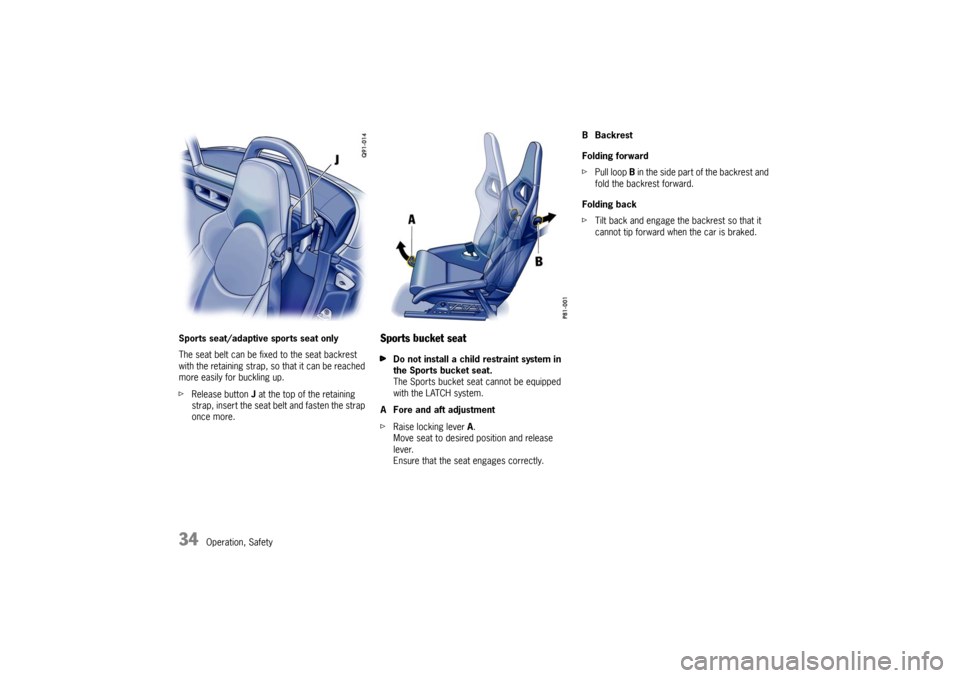
34
Operation, Safety
Sports seat/adaptive sports seat only
The seat belt can be fixed to the seat backrest
with the retaining strap, so
that it can be reached
more easily for buckling up.
f Release button J at the top of the retaining
strap, insert the seat be lt and fasten the strap
once more.
Sports bucket seatf Do not install a child restraint system in
the Sports bucket seat.
The Sports bucket seat cannot be equipped
with the LATCH system.
A Fore and aft adjustment
f Raise locking lever A.
Move seat to desired position and release
lever.
Ensure that the seat engages correctly. BBackrest
Folding forward
f
Pull loop B in the side par t of the backrest and
fold the backrest forward.
Folding back
f Tilt back and engage the backrest so that it
cannot tip forward when the car is braked.
Page 44 of 294

42
Operation, Safety
Safety Belts
Warning!
Always make sure your and your passenger’s
safety belts are properly fastened while the
vehicle is in motion.
Failure to follow safety belt warnings may re-
sult in serious personal injury or death.
f For your and your passenger’s protection, use
safety belts at all times while the vehicle is in
motion.
f Use appropriate child restraint systems for all
small children.
Proper wearing of safety belts
f S a f e t y b e l t s m u s t b e p o s i t i o n e d o n t h e b o d y a s
to restrain the upper body and lap from sliding
forward. Improperly positioned safety belts
can cause serious personal injury or death in
case of an accident.
f The shoulder belt should always rest on your
upper body. The shoulder belt should never be
worn behind your back or under your arm.
f For maximum effectiveness, the lap belt
should be worn low across the hips.
f Pregnant women should position the belt as
low as possible across the pelvis. Make sure it
is not pressing against the abdomen. f
Belts should not be worn twisted.
f Do not wear belts over rigid or breakable ob-
jects in or on your clothing, such as eye glass-
es, pens, keys, etc. as these may cause injury.
f Several layers of heavy clothing may interfere
with proper positioning of belts.
f Belts must not rub against sharp objects or
damage may occur to the belt.
f Two occupants should never share the same
belt at the same time.
Care and maintenance
f Keep belt buckles free of any obstruction that
may prevent a secure locking.
f Belts that have been subjected to excessive
stretch forces in an accident must be inspect-
ed or replaced to ensure their continued effec-
tiveness in restraining you.
The same applies to belt tensioner systems
which have been triggered.
In addition, the anchor points of the belts
should be checked.
f If safety belts do not work properly, see your
authorized Porsche dealer immediately.
f I f t h e b e l t s s h o w d a m a g e t o w e b b i n g , b i n d i n g s ,
buckles or retractors, they should be replaced
to ensure safe operation.
f Do not modify or disasse mble the safety belts
in your vehicle. f
The belts must be kept clean or the retractors
may not work properly.
Please see the chapter “CAR CARE INSTRUC-
TIONS” on Page 213.
f Never bleach or dye safety belts.
f Do not allow safety belts to retract until they
are completely dry after cleaning or this may
cause damage to the belt.
Belt tensioner Depending on the force of an impact, fastened
safety belts are tightened in an accident.
The belt tensioners are triggered in:
– Front, side and rear impacts of sufficient
severity.
– In cases of vehicle rollover.
Note
The belt-tensioner system can be triggered only
once; the system must be replaced afterward.
If there is a fault in the belt-tensioner system, the
airbag warning light lights up.
Work may be performed on the belt-tensioner sys-
tem only by an authorized Porsche dealer.
Smoke is released when the belt tensioners are
triggered. This does not indicate a fire in the
vehicle.
Page 54 of 294
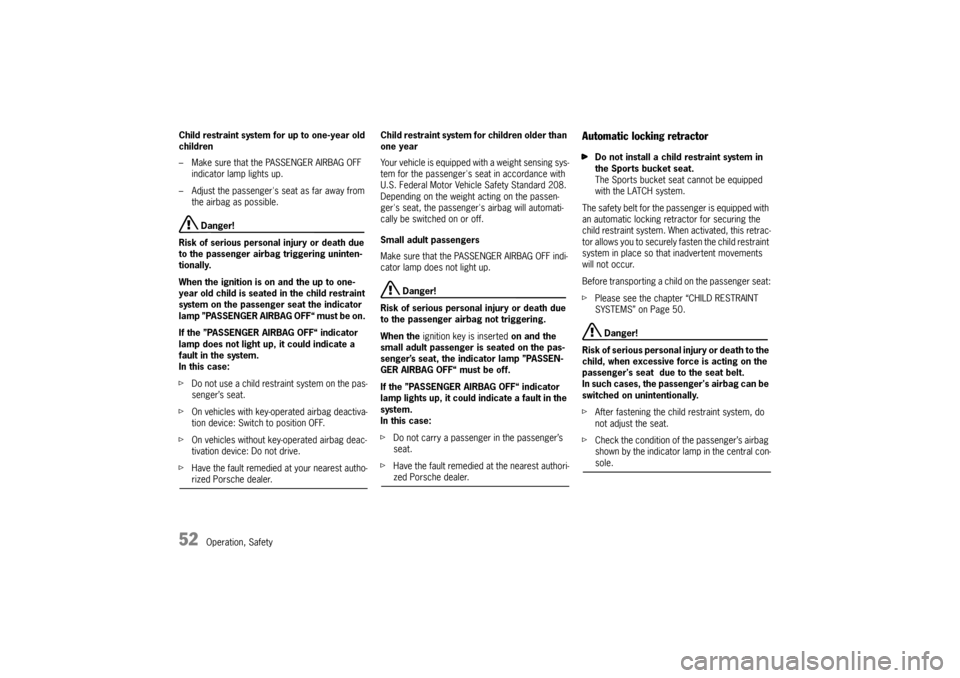
52
Operation, Safety
Child restraint system for up to one-year old
children
– Make sure that the PASSENGER AIRBAG OFF
indicator lamp lights up.
– Adjust the passenger's seat as far away from the airbag as possible. Danger!
Risk of serious personal injury or death due
to the passenger airbag triggering uninten-
tionally.
When the ignition is on and the up to one-
year old child is seated in the child restraint
system on the passenger seat the indicator
lamp ”PASSENGER AIRBAG OFF“ must be on.
If the ”PASSENGER AIRBAG OFF“ indicator
lamp does not light up, it could indicate a
fault in the system.
In this case:
f Do not use a child restraint system on the pas-
senger’s seat.
f On vehicles with key-operated airbag deactiva-
tion device: Switch to position OFF.
f On vehicles without key-operated airbag deac-
tivation device: Do not drive.
f Have the fault remedied at your nearest autho-rized Porsche dealer. Child restraint system fo
r children older than
one year
Your vehicle is equipped with a weight sensing sys-
tem for the passenger's seat in accordance with
U.S. Federal Motor Vehicl e Safety Standard 208.
Depending on the weight acting on the passen-
ger's seat, the passenger's airbag will automati-
cally be switched on or off.
Small adult passengers
Make sure that the PASSENGER AIRBAG OFF indi-
cator lamp does not light up.
Danger!
Risk of serious personal injury or death due
to the passenger airbag not triggering.
When the ignition key is inserted on and the
small adult passenger is seated on the pas-
senger’s seat, the indicator lamp ”PASSEN-
GER AIRBAG OFF“ must be off.
If the ”PASSENGER AIRBAG OFF“ indicator
lamp lights up, it could indicate a fault in the
system.
In this case:
f Do not carry a passenger in the passenger’s
seat.
f Have the fault remedied at the nearest authori-zed Porsche dealer.
Automatic locking retractorfDo not install a child restraint system in
the Sports bucket seat.
The Sports bucket seat cannot be equipped
with the LATCH system.
The safety belt for the passenger is equipped with
an automatic locking retr actor for securing the
child restraint system. When activated, this retrac-
tor allows you to securely fasten the child restraint
system in place so that inadvertent movements
will not occur.
Before transporting a child on the passenger seat:
f Please see the chapter “CHILD RESTRAINT
SYSTEMS” on Page 50.
Danger!
Risk of serious personal injury or death to the
child, when excessive force is acting on the
passenger's seat due to the seat belt.
In such cases, the pass enger's airbag can be
switched on unintentionally.
f After fastening the child restraint system, do
not adjust the seat.
f Check the condition of the passenger’s airbag
shown by the indicator la mp in the central con-sole.
Page 55 of 294

Operation, Safety
53
Activating the automatic locking retractor
1. If a child restraint system must be fastened to the passenger's seat, adjust the passenger's
seat as far away from the airbag as possible.
2. Fasten child seat.
3. Pull the safety belt retractor completely out. At this point the locking mechanism is activated.
4. Insert the safety belt tongue into the buckle
and make certain that it is properly latched.
Make no more adjustments to the seat.
5. Allow the safety belt to retract until it is tight on
the child restraint system. You may further tigh-
ten the belt by pulling on it to allow more of it
to retract.
Make sure that excessive seat belt forces do
not occur by moving the seat with the child
seat installed. Releasing the safety belt
1. Unbuckle the safety belt latch.
2. Then make certain that the
belt has fully retrac-
ted. At this point the automatic locking feature
will be disengaged.
Seek appropriate advice from your authorized
Porsche dealer about the possible installation
of a Porsche child restraint system.
Page 77 of 294

Operation, Safety
75
Starting Procedures fPlease see the chapter “IMMOBILIZER” on
Page 15.
f Please see the chapter “EMISSION CONTROL
SYSTEM” on Page 208.
Warning!
Serious injury or death may result if you are
involved in a collision without having fas-
tened the safety belts.
f Fasten safety belts before driving away. Before starting the engine fApply the footbrake.
f Manual transmission:
Fully depress the clutch pedal and put the gear-
shift lever into neutral.
The clutch pedal must be depressed fully
before the starter will engage.
f In vehicles with PDK transmission:
Move PDK selector lever to position P or N.
Temperature sensors on the engine automatically
provide the correct fuel/air mixture required for
starting.
Therefore, it is not necessary to depress the
accelerator pedal while starting a cold or a
warm engine.
Starting the enginef Turn ignition key to ignition lock position 2.
f As soon as the engine st arts, release the igni-
tion key.
The first operation of the starter is ended automat-
ically when the engine starts.
If the engine does not start, subsequent starter
operations will not be ended automatically.
If the engine fails to start after 10 or 15 seconds
of cranking:
f Wait about 10 seconds before engaging the
starter again.
f When starting the engine, be ready to drive
immediately.
Drive vehicle at moderate speeds and avoid
engine speeds above 4,200 rpm during the
first 5 minutes.
f Do not let the engine idle to warm up.
Danger!
Engine exhaust fumes have many compo-
nents which you can smell. They also contain
carbon monoxide (CO), which is a colorless
and odorless gas.
Carbon monoxide can cause unconscious-
ness and even death if inhaled.
f Never start or let the engine run in an
enclosed, unventilated area.
It is not recommended to sit in your car for prolonged periods with the engine on and the
car not moving.
An unattended vehicle with a running engine
is potentially hazardous.
If warning lights shoul d come on to indicate
improper operation, they would go unno-
ticed.
f Never leave the engine idling unattended.
Danger of fire.
f Do not park or operate the vehicle in areas
where the hot exhaust system may come in
contact with dry grass, brush, fuel spill or oth-
er flammable material.
f If your car catches on fire for any reason, call
the fire department.
Do not endanger your life by attempting to put
out the fire.
Risk of burn injury when standing near or coming
into contact with the exhaust pipe.
The exhaust pipe is hot when the vehicle is running
and remains hot for some time after the vehicle is
turned off.
f To prevent injury, make a point of noting where
your vehicle’s exhaust pipe is, avoid placing
your legs near the exhaust pipe, and closely
supervise children around the vehicle when the
exhaust pipe could be hot.
A hot exhaust pipe can cause serious burns.
Page 78 of 294

76
Operation, Safety
Stopping Engine fTurn key back to position 3.
f Do not stop engine immediately after hard or
extended driving.
Keep engine running at increased idle for
about two minutes to prevent excessive heat
build-up before turning off engine.
f To avoid discharging the battery, always re-
move the ignition key from the ignition lock.
f When leaving the car, always remove the igniti-
on key, apply the parking brake and engage
1st gear or reverse gear on vehicles with ma-
nual transmission or move the selector lever to
position P on vehicles with PDK transmission.
f Engage the steering lock by moving the steer-
ing wheel to the left or right.
Turn the steering wheel to the locking position
before you switch off the engine so that you
don’t have to exert your self when locking or
unlocking the steering.
Warning!
Danger of injury. Hot engine compartment
components can burn skin on contact.
f Before working on any part in the engine
compartment, turn the engine off and let it cool
down sufficiently. Risk of burn injury when standing near or
coming into contact with the exhaust pipe.
The exhaust pipe is hot wh
en the vehicle is running
and remains hot for some time after the vehicle is
turned off.
f To prevent injury, make a point of noting where
your vehicle’s exhaust pipe is, avoid placing
your legs near the exhaust pipe, and closely
supervise children around the vehicle when the
exhaust pipe could be hot.
A hot exhaust pipe can cause serious burns.
Engine-compartment blower,
radiator fan The radiator and radiator fans are in the front of
the car.
The engine-compartment bl ower is mounted in the
engine compartment.
Warning!
Risk of injury.
After the engine is switched off, the engine-
compartment temperature is monitored for
approx. 30 minutes.
During this period, and depending on tem-
perature, the engine-compartment blower
may continue to run or start to run.
f Carry out work in these areas only with the en-
gine off, the ignition off, and exercise extreme
caution. Risk of injury. The radiator fans in the front
end of the car may be operating or
unexpectedly start operating when the
engine is switched on.
f
Carry out work in these areas only with the en-
gine switched off.
Automatic garage door The ignition system in your Porsche may interfere
with your electronically operated garage door.
fTo check this, drive your Porsche close to the
garage door. Make sure not to interfere with
the operating range of the door.
f Run the engine at different speeds.
f If the garage door opens or closes without you
operating the garage door unit in your car,
contact the dealer who installed the automatic
garage door to have the frequency and/or
coding of the garage door signal changed or
modified.
Page 90 of 294
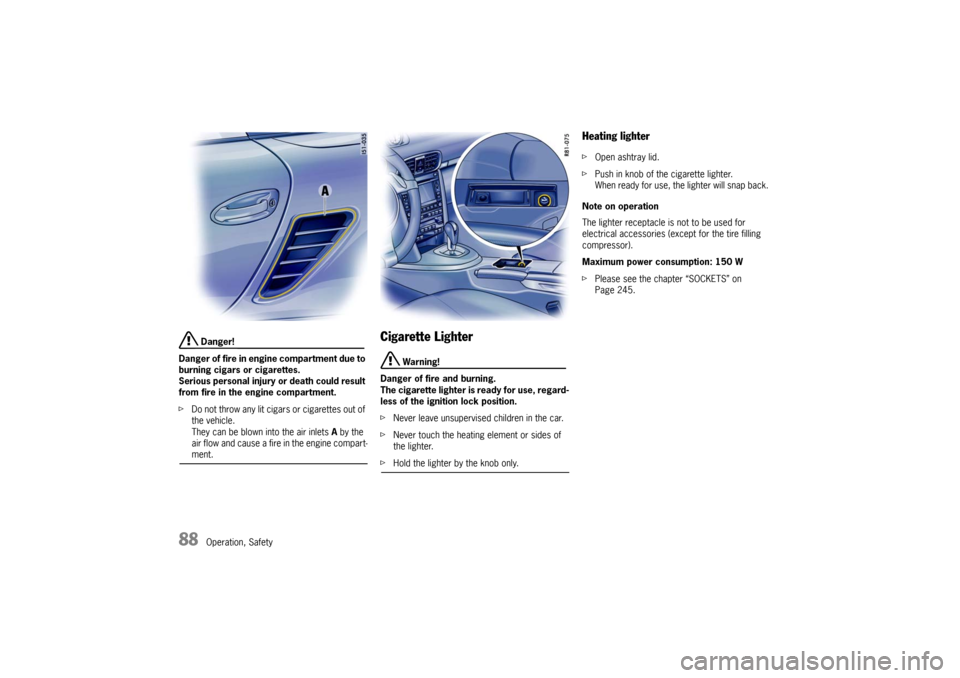
88
Operation, Safety Danger!
Danger of fire in engine compartment due to
burning cigars or cigarettes.
Serious personal injury or death could result
from fire in the engine compartment.
f Do not throw any lit cigars or cigarettes out of
the vehicle.
They can be blown into the air inlets A by the
air flow and cause a fire in the engine compart-ment.
Cigarette Lighter
Warning!
Danger of fire and burning.
The cigarette lighter is ready for use, regard-
less of the ignition lock position.
f Never leave unsupervised children in the car.
f Never touch the heating element or sides of
the lighter.
fHold the lighter by the knob only.
Heating lighter fOpen ashtray lid.
f Push in knob of the cigarette lighter.
When ready for use, the lighter will snap back.
Note on operation
The lighter receptacle is not to be used for
electrical accessories (except for the tire filling
compressor).
Maximum power consumption: 150 W
f Please see the chapter “SOCKETS” on
Page 245.